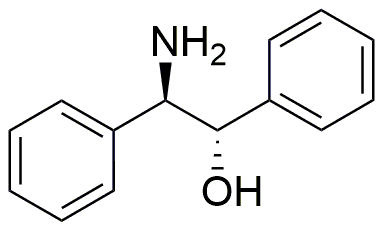(1S,2R)-(+)-2-Amino-1,2-diphenylethanol is widely utilized in research focused on:
- Pharmaceutical Development: This compound serves as a chiral building block in the synthesis of various pharmaceuticals, enhancing the efficacy and safety of drugs by enabling the production of enantiomerically pure compounds.
- Catalysis: It is employed as a ligand in asymmetric catalysis, facilitating reactions that produce specific stereoisomers, which are crucial in the manufacture of fine chemicals and agrochemicals.
- Biochemical Research: Researchers use this compound to study its interactions with biological systems, contributing to the understanding of enzyme mechanisms and receptor binding, which is vital in drug discovery.
- Material Science: The compound's unique properties make it suitable for developing advanced materials, such as polymers and composites, that require specific mechanical and thermal characteristics.
- Chiral Separation Techniques: It is utilized in chiral chromatography for the separation of enantiomers, which is essential in various industries, including food and beverage, to ensure product quality and regulatory compliance.
General Information
Properties
Safety and Regulations
Applications
(1S,2R)-(+)-2-Amino-1,2-diphenylethanol is widely utilized in research focused on:
- Pharmaceutical Development: This compound serves as a chiral building block in the synthesis of various pharmaceuticals, enhancing the efficacy and safety of drugs by enabling the production of enantiomerically pure compounds.
- Catalysis: It is employed as a ligand in asymmetric catalysis, facilitating reactions that produce specific stereoisomers, which are crucial in the manufacture of fine chemicals and agrochemicals.
- Biochemical Research: Researchers use this compound to study its interactions with biological systems, contributing to the understanding of enzyme mechanisms and receptor binding, which is vital in drug discovery.
- Material Science: The compound's unique properties make it suitable for developing advanced materials, such as polymers and composites, that require specific mechanical and thermal characteristics.
- Chiral Separation Techniques: It is utilized in chiral chromatography for the separation of enantiomers, which is essential in various industries, including food and beverage, to ensure product quality and regulatory compliance.
Documents
Safety Data Sheets (SDS)
The SDS provides comprehensive safety information on handling, storage, and disposal of the product.
Product Specification (PS)
The PS provides a comprehensive breakdown of the product’s properties, including chemical composition, physical state, purity, and storage requirements. It also details acceptable quality ranges and the product's intended applications.
Certificates of Analysis (COA)
Search for Certificates of Analysis (COA) by entering the products Lot Number. Lot and Batch Numbers can be found on a product’s label following the words ‘Lot’ or ‘Batch’.
*Catalog Number
*Lot Number
Certificates Of Origin (COO)
This COO confirms the country where the product was manufactured, and also details the materials and components used in it and whether it is derived from natural, synthetic, or other specific sources. This certificate may be required for customs, trade, and regulatory compliance.
*Catalog Number
*Lot Number
Safety Data Sheets (SDS)
The SDS provides comprehensive safety information on handling, storage, and disposal of the product.
DownloadProduct Specification (PS)
The PS provides a comprehensive breakdown of the product’s properties, including chemical composition, physical state, purity, and storage requirements. It also details acceptable quality ranges and the product's intended applications.
DownloadCertificates of Analysis (COA)
Search for Certificates of Analysis (COA) by entering the products Lot Number. Lot and Batch Numbers can be found on a product’s label following the words ‘Lot’ or ‘Batch’.
*Catalog Number
*Lot Number
Certificates Of Origin (COO)
This COO confirms the country where the product was manufactured, and also details the materials and components used in it and whether it is derived from natural, synthetic, or other specific sources. This certificate may be required for customs, trade, and regulatory compliance.


